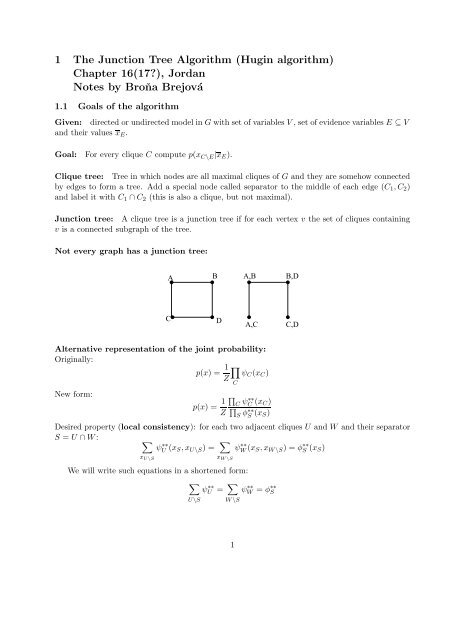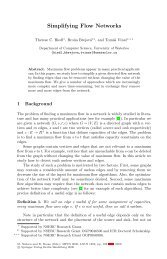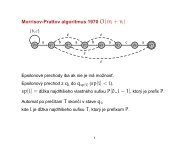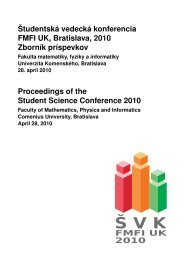1 The Junction Tree Algorithm (Hugin algorithm) Chapter 16(17 ...
1 The Junction Tree Algorithm (Hugin algorithm) Chapter 16(17 ...
1 The Junction Tree Algorithm (Hugin algorithm) Chapter 16(17 ...
You also want an ePaper? Increase the reach of your titles
YUMPU automatically turns print PDFs into web optimized ePapers that Google loves.
1 <strong>The</strong> <strong>Junction</strong> <strong>Tree</strong> <strong>Algorithm</strong> (<strong>Hugin</strong> <strong>algorithm</strong>)<br />
<strong>Chapter</strong> <strong>16</strong>(<strong>17</strong>?), Jordan<br />
Notes by Broňa Brejová<br />
1.1 Goals of the <strong>algorithm</strong><br />
Given: directed or undirected model in G with set of variables V , set of evidence variables E ⊆ V<br />
and their values xE.<br />
Goal: For every clique C compute p(x C\E|xE).<br />
Clique tree: <strong>Tree</strong> in which nodes are all maximal cliques of G and they are somehow connected<br />
by edges to form a tree. Add a special node called separator to the middle of each edge (C1,C2)<br />
and label it with C1 ∩ C2 (this is also a clique, but not maximal).<br />
<strong>Junction</strong> tree: A clique tree is a junction tree if for each vertex v the set of cliques containing<br />
v is a connected subgraph of the tree.<br />
Not every graph has a junction tree:<br />
Alternative representation of the joint probability:<br />
Originally:<br />
p(x) = 1 <br />
ψC(xC)<br />
Z<br />
New form:<br />
x U\S<br />
A<br />
C<br />
B<br />
D<br />
C<br />
A,B B,D<br />
A,C C,D<br />
p(x) = 1<br />
<br />
C<br />
Z<br />
ψ∗∗ C (xC)<br />
<br />
S φ∗∗<br />
S (xS)<br />
Desired property (local consistency): for each two adjacent cliques U and W and their separator<br />
S = U ∩ W: <br />
ψ ∗∗<br />
U (xS,x U\S) = <br />
ψ ∗∗<br />
W (xS,x W \S) = φ ∗∗<br />
S (xS)<br />
x W \S<br />
We will write such equations in a shortened form:<br />
<br />
U\S<br />
ψ ∗∗<br />
U = <br />
W \S<br />
1<br />
ψ ∗∗<br />
W = φ ∗∗<br />
S
Later we will prove that if local consistency is true for every edge of a junction tree, then for<br />
every clique C and every separator S:<br />
p(xC) ∝ ψ ∗∗<br />
C<br />
(i.e., we get our desired marginals).<br />
1.2 <strong>The</strong> <strong>Hugin</strong> <strong>algorithm</strong> (s. <strong>16</strong>.11)<br />
p(xS) ∝ φ ∗∗<br />
S<br />
• Moralization: directed graph → undirected graph<br />
• Introduction of evidence: representation of p(x V \E,xE) → representation of p(x V \E|xE).<br />
• Triangulation: graph → graph that has a junction tree.<br />
• Construction of the junction tree: find cliques, separators, initialize φS = 1.<br />
• Propagation of probabilities: achieve local consistency for every edge.<br />
1.3 Propagation of probabilities (s. <strong>16</strong>.5, <strong>16</strong>.6)<br />
Let us assume that we already have an undirected graph with a junction tree (and no observed<br />
variables). We want to manipulate local functions ψ and φ so that the joint probability stays the<br />
same<br />
and local consistency holds for each edge<br />
Function UPDATE(U,W):<br />
p(x) = 1<br />
Z<br />
<br />
C ψC(xC)<br />
<br />
S φS(xS)<br />
<br />
ψU = <br />
ψW = φS<br />
U\S<br />
φ ∗ S<br />
W \S<br />
= <br />
U\S<br />
ψU<br />
ψ ∗ W = φ∗S ψW<br />
φS<br />
ψ ∗ U = ψU<br />
Lemma 1. Function UPDATE satisfies the following properties<br />
1. <strong>The</strong> joint probability remains the same (i.e. ψWψU/φS = ψ ∗ W ψ∗ U /φ∗ S ).<br />
2. <br />
U\S ψ∗ U = φ∗ S .<br />
3. If <br />
W \S ψW = φS, then also <br />
W \S ψ∗ W = φ∗ S<br />
2
Proof. <strong>The</strong> first property was proved in the last class. <strong>The</strong> second property clearly holds from<br />
definition of φ ∗ S and ψ∗ U .<br />
<br />
ψ<br />
W \S<br />
∗ W = φ<br />
W \S<br />
∗ S<br />
ψW<br />
φS<br />
= φ∗ <br />
S<br />
ψW<br />
φS<br />
W \S<br />
= φ∗S φS<br />
φS<br />
= φ ∗ S<br />
Corollary 1. After UPDATE(U,W) and UPDATE(W,U) the local consistency holds for U and<br />
W.<br />
Message-passing protocol. How to do UPDATE’s in a junction tree with more than 2 vertices?<br />
Root the tree in an arbitrary node, then first send messages from the leaves towards the root and<br />
then from the root back towards the leaves.<br />
function Main:<br />
CollectEvidence(root)<br />
DistributeEvidence(root)<br />
function CollectEvidence(node W)<br />
for each child U of node<br />
CollectEvidence(U)<br />
Update(U, W)<br />
function DistributeEvidence(node W)<br />
for each child U of node<br />
Update(W, U)<br />
CollectEvidence(U)<br />
It is easy to see that if U is a child of W and S is their separator, then after CollectEvidence(W)<br />
finishes, <br />
U\S ψ∗ U = φ∗S . Recursion then continues in other parts of the tree, but they do not change<br />
U nor S, therefore this holds until we execute DistributeEvidence(W). At this point part 3 of the<br />
lemma applies and therefore after UPDATE(W,U) both U and W will marginalize correctly. Since<br />
that point we will not change neither U nor W.<br />
1.4 Final proof: If local consistence holds in a junction tree then local functions<br />
are marginal probabilities (s. <strong>16</strong>.7)<br />
<strong>The</strong>orem 1. Let probability p(x) be represented by the clique potentials ψC and separator potential<br />
φS. <strong>The</strong>n if the local consistence holds for each edge in the juction tree, then clique and separator<br />
3
potentials are proportional to local marginal probabilities:<br />
ψC ∝ p(xC)<br />
φS ∝ p(xS)<br />
Proof. <strong>The</strong> separators are subsets of cliques. By local consistency, if clique potentials are proportional<br />
to marginals, then so are separators. <strong>The</strong>refore we only need to prove the results for clique<br />
potentials.<br />
<strong>The</strong> proof by induction in the number of cliques. For a single clique it holds by the definition<br />
of p(x) = φC(x)/Z. Let us suppose that the results holds for junction trees with N cliques and<br />
consider a junction tree with N + 1 cliques.<br />
Let C be a leaf in the juction tree. Let S be the separator for this node, and let R = C \ S,<br />
T = V \ C. Sets R, S and T are disjoint and their union is V . Vertices in R do not occur in any<br />
other clique except C by junction tree property. <strong>The</strong>refore S separates R from the rest of the tree<br />
and R ⊥ T |S.<br />
p(xS,xT) = <br />
p(x)<br />
= 1<br />
Z<br />
= 1<br />
Z<br />
R<br />
<br />
<br />
C<br />
R<br />
<br />
R<br />
′ ψC(xC)<br />
<br />
S ′ φS(xS)<br />
ψC(xC) <br />
C ′ =C ψC ′(xC ′)<br />
φS(xS) <br />
<br />
R ψC(xC)<br />
S ′ =S<br />
<br />
C ′ =C<br />
φS ′(xS ′)<br />
= 1<br />
Z ·<br />
ψC ′(xC ′)<br />
· <br />
φS(xS) S ′ =S φS ′(xS ′)<br />
= 1<br />
Z ·<br />
<br />
C ′ =C ψC ′(xC ′)<br />
<br />
S ′ =S φS ′(xS ′)<br />
This shows that p(xS,xT) is represented by clique potentials and separator potentials on the junction<br />
tree over S ∪ T. By the induction hypothesis the clique potential on this tree are equal to<br />
marginals.<br />
It remains to show that the clique potential on C is a marginal. <strong>The</strong> neighbour of C in the tree<br />
is a marginal and since S is locally consistent with this neighbour, φS(xS) ∝ p(xS).<br />
Since R ⊥ T |S, we have that p(xR|xS,xT) = p(xR|xS) and therefore<br />
<strong>The</strong>refore<br />
p(x) = p(xR|xS,xT)p(xS,xT) = p(xR|xS)p(xS,xT)<br />
p(xR|xS) =<br />
=<br />
p(x)<br />
p(xS,xT)<br />
1<br />
Z ·<br />
<br />
C ψC(xC)<br />
<br />
S φS(xS)<br />
1<br />
Z ·<br />
<br />
C ′ =C ψC ′(xC ′)<br />
<br />
S ′ =S φS ′(xS ′)<br />
4<br />
(1)<br />
(2)
<strong>The</strong>refore ψC(xC) ∝ p(xR|xS)p(xS) = p(xC).<br />
1.5 Moralization (s. <strong>16</strong>.2)<br />
= ψC(xC)<br />
φS(xS)<br />
∝ ψC(xC)<br />
p(xS)<br />
• For each node Xi connect all parents of Xi to a clique<br />
• Drop orientation of edges<br />
• For each node Xi multiply p(xi|xπi ) onto potential of a maximal clique containing πi ∪ {Xi}<br />
(choose one of possibly several such cliques).<br />
<strong>The</strong> new undirected model represents the same distribution.<br />
1.6 Introduction of evidence (s. <strong>16</strong>.3)<br />
Let H = V \ E. Assume xE is fixed (evidence).<br />
˜ψC∩H(xC∩H) def<br />
= ψC(xC∩H,xC∩E )<br />
<br />
xC<br />
This corresponds to taking a slice of the local function.<br />
Example:<br />
If E = {Y } and y = 1, we get<br />
ψ {X,Y } =<br />
˜ψY =<br />
<br />
<br />
0.12 0.08<br />
0.24 0.56<br />
0.08<br />
0.56<br />
p(xH|xE) = p(xH,xE)<br />
p(xE)<br />
<br />
=<br />
=<br />
<br />
1<br />
Z C ψC(xC∩H,xC∩E)<br />
<br />
H 1 <br />
Z C ψC(xC∩H,xC∩E)<br />
<br />
C ˜ ψC∩H(xC∩H)<br />
<br />
˜ψC∩H(xC∩H)<br />
<br />
H C<br />
<br />
Z ′<br />
= 1<br />
Z ′<br />
<br />
˜ψC∩H(xC∩H)<br />
C<br />
5<br />
(3)<br />
(4)<br />
(5)
˜ψC∩H(xC∩H) are local functions associated with cliques C ∩H of induced subgraph G[H]. Each<br />
maximal clique in G[H] is in fact in set of cliques {C ∩ H|C is a clique in G}, but we may get<br />
cliques that are not maximal or C1 ∩ H = C2 ∩ H for some C1 = C2. We just multiply together all<br />
local function associated with one maximal clique and its subcliques.<br />
Example:<br />
A<br />
B<br />
Assume E={A}<br />
C<br />
D<br />
C<br />
D<br />
Cliques {A,B,C} and {B,C,D} Cliques {B,C} and {B,C,D}<br />
B<br />
Assume E={A,D}<br />
C<br />
B<br />
Cliques {B,C} and {B,C}<br />
So for given graph G, set of local functions ψC representing p(xH,xE), and set of evidence variables<br />
E we have obtained a new graph G ′ , new set of local functions ˜ ψ ′ C that represents p(xH|xE).<br />
So from now on we do not need to worry about evidence E – instead of computing p(xC∩H|xE)<br />
in the old graph we compute p(xC∩H) in the new graph.<br />
• In the book some places consider the evidence in the later parts of the <strong>algorithm</strong> and some<br />
do not.<br />
• I am not sure whether it is good in practice to transform the graph in this way.<br />
• Anyway, we will do all proofs without evidence and you can figure out yourselves how the<br />
evidence will change it.<br />
1.7 Triangulation (s. <strong>16</strong>.8, <strong>16</strong>.14.2 (appendix))<br />
• Not every graph has a junction tree<br />
• <strong>The</strong> rest of the <strong>algorithm</strong> only works for the junction tree<br />
• Given graph G we add some edges to get a new graph G ′ that has a junction tree.<br />
• By adding edges we change the set of maximal cliques, but again each local function can be<br />
multiplied onto one of the cliques for which it is subset.<br />
Definition 1. A chord of a cycle in a graph is edge connecting two vertices not adjacent in the<br />
cycle. A cycle is chordless if it has no chords. A graph is triangulated (also called chordal), if no<br />
cycle of length at least 4 is chordless.<br />
Example:<br />
6
not triangulated<br />
triangulated<br />
<strong>The</strong>orem 2. A graph has a junction tree if and only if it is triangulated.<br />
We will prove ⇐ direction only, needed to prove correctness of the <strong>algorithm</strong>.<br />
Observation: Let A ⊆ V and let G[A] is subgraph induced by A, i.e. G[A] = (A,E ∩ A 2 ). If G<br />
is triangulated, then so is G[A].<br />
Lemma 2. Let G = (V,E) be a non-complete triangulated graph with at least three nodes. <strong>The</strong>n<br />
there exists a decomposition of V into non-empty disjoint sets A, B, and S such that S is complete<br />
and it separates A and B (i.e. every path from a vertex in A to a vertex in B goes through a vertex<br />
in S).<br />
Proof. If graph not connected, choose S as a single vertex and each of A and B contain some<br />
connected components.<br />
Choose a pair of non-adjacent nodes α and β. Let S be the minimal set of nodes such that any<br />
path from α to β passes through S. Let A be the set of nodes reachable from α when S is removed,<br />
B be the set of nodes reachable from β when S is removed and let X = V \ (A ∪ B ∪ S). Note<br />
that X may be empty. Clearly A ∪ X and B are separated by S. We only need to prove that S is<br />
complete.<br />
Let C and D be non-adjacent nodes in S. Both C and D have neighbours in both A and B,<br />
because S is minimal. Neighbour of C in A and neighbour of D in A are connected in A (at least<br />
through α). Take the shortest path from C to D that uses only vertices in A as internal vertices.<br />
Similarly take the shortest path from C to D that uses only vertices in B as internal vertices. Joins<br />
these paths – you get cycle of length at least 4. It must have a chord. This chord cannot be edge<br />
(C,D), because they are non-adjacent. <strong>The</strong> cord cannot be entirely in A because the path was<br />
chosen as shortest. It cannot be from a vertex in A to C or D for the same reason. By symmetry the<br />
same holds for B. It cannot go from A to B because then S is not a separator. Contradiction.<br />
Definition 2. A node is simplicial if all of its neighbours are connected.<br />
Lemma 3. Every triangulated graph that contains at least two nodes has at least two simplicial<br />
nodes. If the graph is not complete, then these nodes can be chosen to be non-adjacent.<br />
Proof. We use induction on the number of vertices. As a base case the proof holds for the graph<br />
with two vertices.<br />
Consider triangulated graph with N+1 vertices. If complete, every node is simplicial. Otherwise<br />
we decompose the graph into A, B and S as in the previous lemma. Subgraph G[A ∪ S] is<br />
triangulated and by induction hypothesis it has at least two simplicial nodes. If G[A ∪ S] is not<br />
complete, choose these two nodes non-adjacent. <strong>The</strong>n at least one of them is in A (S is complete).<br />
7
This node is simplicial in G[A ∪ S] and it has no neighbours in B, therefore it is simplicial in G as<br />
well. If G[A ∪ S] is complete, choose any vertex in A – it is simplicial in G. By symmetry we can<br />
find simplicial node in B. <strong>The</strong>se two nodes are non-adjacent.<br />
Lemma 4. Every triangulated graph has a junction tree.<br />
Proof. Again use induction and base case |V | = 1 is trivial. Consider graph G with N + 1 nodes.<br />
It has a simplicial node α. We remove α, getting an induced subgraph G ′ = G[V \ {α}] which is<br />
triangulated. By induction hypothesis graph G ′ has a junction tree T.<br />
Let C by the clique formed by α and its neighbours, and let C ′ = C \ {α}. C is maximal clique<br />
in G because no other vertex is connected to α. It is also the only maximal clique in G containing<br />
α.<br />
If clique C ′ is a node in T, we add α to this node to get a junction tree for G.<br />
If C ′ is not a node in T, then it most be a subset of at least one maximal clique D. Add C as<br />
a new node to T, connected as a leaf to clique D. <strong>The</strong> resulting tree is a junction tree because (1)<br />
α is only in clique C and (2) all other vertices in C are in D as well.<br />
Note: <strong>The</strong> proof implies that the number of maximal cliques in a triangulated graph is at most<br />
|V |. In general graph it can be exponential (consider a graph that is a complement to a path of<br />
length n).<br />
<strong>Algorithm</strong> for triangulation: If we triangulate the graph (add edges until it is triangulated),<br />
we get a graph with a junction tree. However how to triangulate the graph? One way is to use<br />
elimination <strong>algorithm</strong> from <strong>Chapter</strong> 3. Again we have to be careful about elimination orders.<br />
Triangulate(G, elimination order of vertices O)<br />
if G has one vertex, return G<br />
let v be the first vertex in O<br />
form a clique from neighbours of v in G<br />
Triangulate(G-v,O-v)<br />
<strong>The</strong>orem 3. <strong>The</strong> procedure described above yields a triangulated graph.<br />
Proof. By induction. Trivial for graph with 1 vertex. Consider graph with N + 1 nodes. We<br />
eliminate node and by induction the new graph with N nodes is triangulated. By adding the new<br />
node v we do not create any chordless cycles because all neighbours are connected.<br />
Jensen 1996: if a graph is triangulated there exists an ordering such that elimination <strong>algorithm</strong><br />
does not introduce any new edges.<br />
1.8 Construction of the junction tree (s. <strong>16</strong>.9, <strong>16</strong>.10)<br />
We know that the triangulated graph has a junction tree and the proof of Lemma 4 has a recursive<br />
procedure for constructing it by eliminating a simplicial vertex, constructing the tree for the rest<br />
of the graph and then adding the vertex either to some existing node or creating a new leaf.<br />
8
Different construction: Find all maximal cliques, create a graph with cliques as nodes and<br />
size of separator as a weight of an edge, find maximum weight spanning tree (Prim’s or Kruskal’s<br />
<strong>algorithm</strong>). This tree is a junction tree.<br />
Why? Consider variable Xk. If it is included in j maximal cliques, it will be in at most j − 1<br />
separators in any clique tree. In addition, this number will be j − 1 only if the cliques containing<br />
Xk form a connected subgraph of the tree. <strong>The</strong>refore the junction tree has the largest possible sum<br />
of separator sizes over all spanning trees.<br />
1.9 Computational complexity (s. <strong>16</strong>.13)<br />
• Moralization: O(N 2 ) + manipulation of tables<br />
• Introduction of evidence: O(N + M) + manipulation of tables<br />
• Triangulation: NP-hard to find optimal triangulation, but can be done heuristically in<br />
polytime + manipulation of tables<br />
• Construction of the junction tree: O(N 2 ) using maximum spanning tree, or O(N 3 )<br />
recursively.<br />
• Propagation of probabilities: O(N) messages passed, each needs table manipulation<br />
Size of a table is r k where r is the number of values per variable, k is the size of a clique. <strong>The</strong> main<br />
problem is to keep cliques small (in triangulation phase).<br />
9









